Sparks will fly!

AJAYA'S CRUISE
Phil & Nikki Hoskins
Sun 15 Jan 2017 18:40
|
Still in George Town
We have been attached to a mooring in Hole 1 at Stocking Island for the
past eight days, the anchor enjoying a mid-term rest on the stem head roller.
The weather from a wind prospective has been the longest time we have endured
such conditions since we were imprisoned off Cape Sounion in Greece many many
years ago. That was nine days of sheer misery on a much smaller boat without
actually knowing when it would stop blowing. We almost ran out of food in the
process. Nowadays things are different and we can time almost to the minute when
the wind will start or stop and how strong it will blow. But of course you still
have to weather the event. Anyway that’s all beside the point. The reason we
took a mooring was that we’d been suffering charging issues from the engine
alternators which feed through a very clever zero loss split charge diode
system. All very hocus pocus black art stuff which we barely understand
ourselves but since we fitted the various components over a few years it’s
always performed extremely well and that’s all you can ask.
Unfortunately over the past few weeks things haven’t worked exactly as they
should. Without going into tedious amounts of detail (although he probably will
!!! Ed.) warning lights at the engine control panel indicating over voltages on
the start battery circuit started to blink. Because of that clever diode thingy
it wouldn’t let any charge get to our house batteries that run the fridges,
lights, water pumps etc. The solar energy continued to work fine through all
this so we did have power into the house batteries. But when motoring for
the amount of time we’ve been doing recently it’s unacceptable for such warnings
to be ignored. So having reached the relative security of George Town we needed
to sort this issue out. With gale force winds forecast over a period of some
days we rented the mooring from ‘Little Toot’ for as long as we needed its
security. Firmly secured we could set about investigating what the problem
was and if we needed to ship any parts into George Town before heading off
again. As the over voltage was being experienced on the engine start
battery it seemed logical to switch that out with a brand new battery we are
carrying to see if it was the offending item.
Our battery box in the cockpit is not an area to go poking around in. Just
gazing into the mass of batteries and heavy duty leads is enough to think of
other things I could be doing onboard.
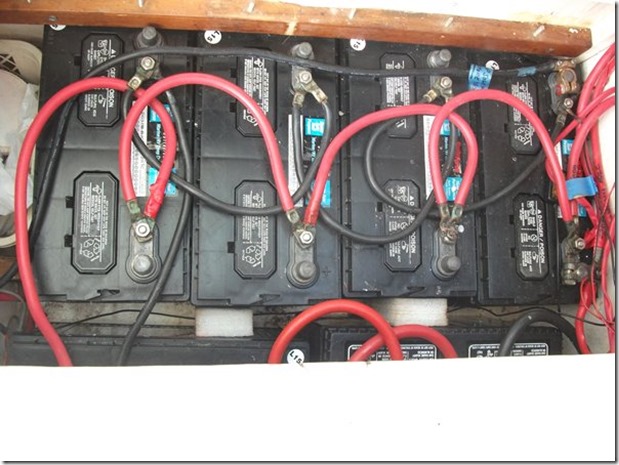
Pandora’s Box
There’s a massive amount of available power on tap should the wrong lead or
a spanner fall in the wrong place. Memories from the past come back of when I
accidently bridged the terminals on my old Ford Anglia starter battery with a
spanner whilst removing it from the car resulting in a small area of the skin of
my index finger melting with the heat. Unfortunately the engine start battery we
have onboard is tucked partly under the cockpit floor surrounded by our five
battery house bank. All linked into the whole system with some mighty thick red
and black leads – none particularly flexible. There are evil spirits living in
battery boxes. Rather like those in Pandora’s Box, ready to emerge. Nasty things
happen to those unfortunate enough to tangle with those battery demons. When you
remove leads and pull a battery out those demons somehow take control of those
loose leads and manoeuver them back towards where they had been previously
secured. Now there is no where for them to rest so they choose the next
available place to land which is on a different terminal altogether. That is, a
big black negative cable would naturally land on a big fat positive
terminal...........................
(Hang in there – Ed)
Before lifting the battery that was the possible cause of our overcharging
woes clear the replacement battery was stood on wooden slats atop the house
bank. There the start battery cables would reach its terminals and the engines
were started. Bingo! All was working normally again. It was the battery after
all and as we were carrying a spare in the cockpit locker it just remained for
the ‘dead’ battery to be removed and for the replacement to be installed. The
slats were left in position covering the positive terminals of the adjoining
house bank. The old start battery was lifted out at an angle to clear the
cockpit floor........................................
(Wait for it! – Ed)
With the forty pound battery almost out of it’s hole the slats covering the
positive terminals became dislodged. With both hands still occupied hauling the
battery away from the locker those spirits mobilised all their available forces
to ensure that the negative cable of the start battery shifted from it’s safe
position parked to one side of the locker straight onto the positive terminal of
No.2 house battery. There was an initial flash as the cable bounced off the
terminal. Horror of horrors it then as if by magic firmly settled itself
at the same point on the terminal a split second later. This time it was there
to stay. In a scene reminiscent of the creation of Frankenstein’s Monster there
were massive sparks along with pieces of molten metal being flung all over the
house bank. The old starter battery had now been hastily parked. Automatic
reactions kicked in to pull what was left of the circular lug terminal of the
negative with its attendant cable off of the positive terminal before the bank
could explode. Something the boffins mention in their manuals and on the
internet. (Air is blue – Ed)
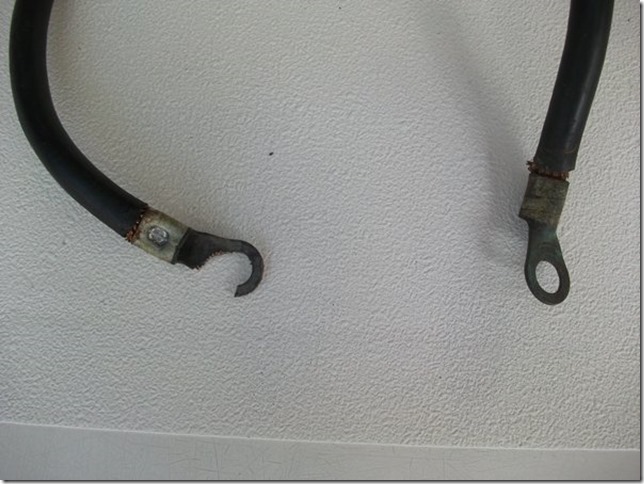 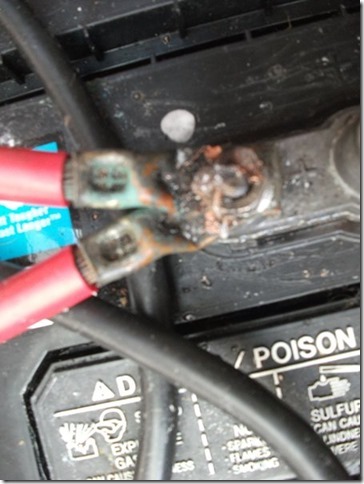 They used to be exactly the same each end
!
Number 2 battery terminal - a molten mess
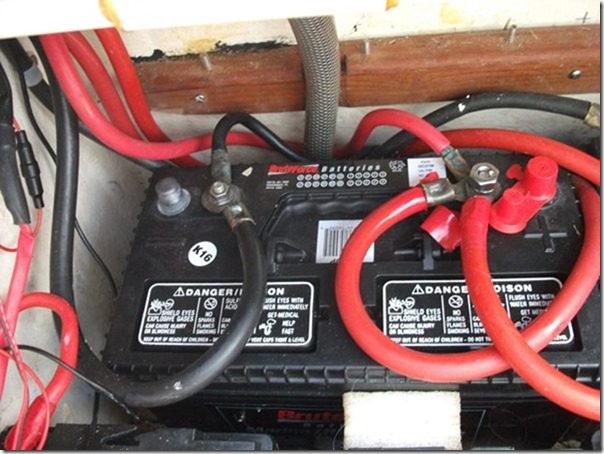
Replacement starter battery finally in place at last – with a spare replacement
cable fitted
Calculating the potential damage resulting from what had just transpired
began in my mind almost immediately. After all, these batteries are meant to
spend their days gently providing small amounts of current to the fridges,
lights, instrumentation, computers and our good old television. They are not
suitable for arc welding or metal melting on the scale of what had just been
witnessed. It was safe to assume that whatever charging woes we had been
experiencing to date would now be inconsequential given that we probably didn’t
have a battery bank to charge anymore. We could be in some serious
trouble.
Where to start first? Well, was anything electrical still actually
functioning onboard? Yes, the day fridge was. That was strange as the first
thing I would have expected would be for the main 100 amp fuse to blow. Well, it
didn’t. Were the solar panels still imputing? Yes they were. The protecting fuse
was still intact between the solar input and the house bank. So what next. Check
the batteries themselves. Well, number 2 looked like it had been in a fight with
something hot. In fact it’s own positive leads were welded to the terminal so if
this battery was going to be removed anytime soon it’s leads would have to be
cut free. Next the specific gravities were taken on the 30 individual cells that
make up the battery bank. All were in the red sector indicating a poor charge.
So that was that. The house bank looked to be on it’s way out. Not a disaster
except to the bank account perhaps.
So we have remained on this mooring for eight days now. With winds to forty
five knots blowing over the bow. Getting ashore to buy even an onion has been
impossible unless we took the water taxi. We were OK for onions anyway and
strangely enough the batteries have shown a tendency to recuperate over the past
few days as well. The critical factor was what would happen when that day’s
solar input had ceased with the setting sun. Would the voltage capitulate in the
night hours with both fridges demanding their share of amps? We immediately
reduced the setting on the big fridge to a more sensible temperature (we have no
fish to go off yet) and ran the engine at 10 pm that first night to give the
batteries some overnight assistance. All was well the next morning. That is
things were no worse than before the big flash. The capacity of the bank isn’t
what it was at new but they are relatively cheap batteries and last at best
three seasons anyway.
We not so much dodged a bullet as a missile which is what the batteries
would have become had the lead stayed in place on that terminal. Now all we need
is to find a local priest who can exorcise those demons from that battery box
before they can do any more damage. Of course I should have removed the link
negative cable from the house to the start battery and shut all systems down –
especially the solar. (Silly Boy!) But you think you have the situation under
control and all the angles covered. But I didn’t of course.
Meanwhile when we’re not staring down into battery boxes we managed to get
ashore for a look back to where we’ve spent the last week or so.
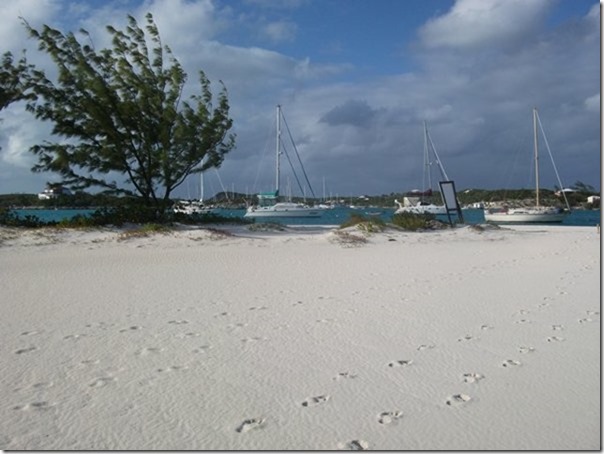
There we are – dead centre, just offshore
|